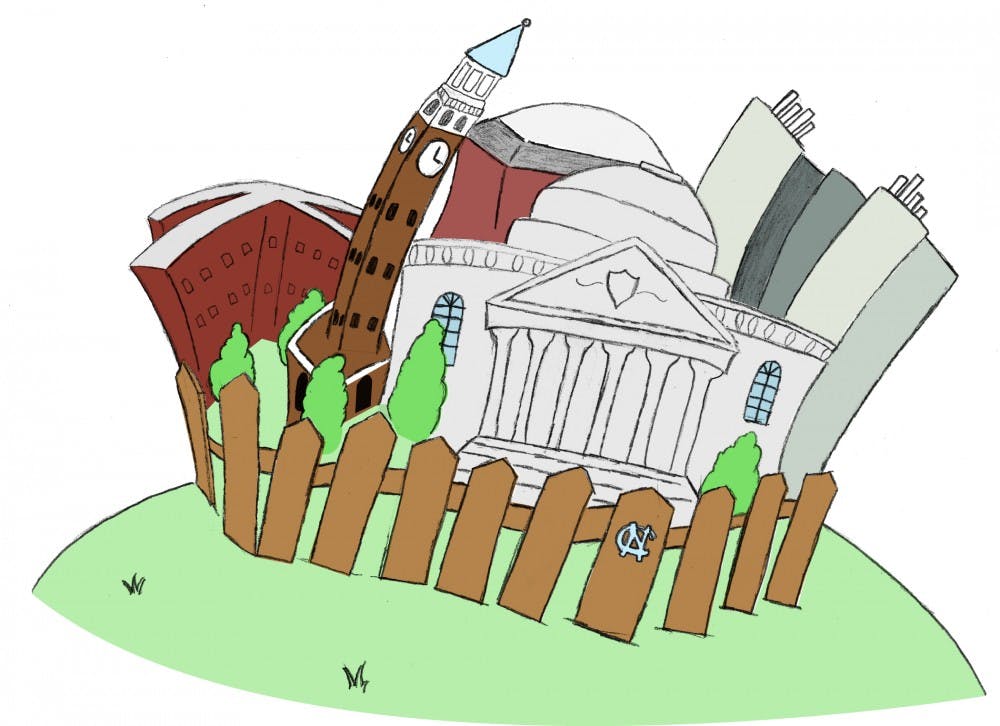Of the four main projects the University wants to build in Carolina North’s initial stages — two research buildings, the new law school and residential housing — Research Building One is the only project that the school can fund so far.
It will be financed by a debt service, leveraged with lease money that would otherwise be paid to house research groups around town.
Those groups will ultimately move to the building.
“We’ve been carefully monitoring the length of the leases for all these groups, and now feel like this is the opportunity to start the development,” Wu said.
But she said UNC’s much-needed new School of Law has been put on hold because it is budgeted to cost $153 million, more than the state can afford.
Eventually, the University wants to convert the current law school to be part of the College of Arts and Sciences.
Wu said getting state-appropriated funding for the new law building remains a top priority for the University this legislative budgeting session, despite delays since 2008.
Jack Evans, former Executive Director of the Carolina North project, agreed.
“The state of the economy has dramatically altered, or at least slowed down, all of those plans,” he said. “The economy has been the elephant in the room.”
Though the University can’t fund any other buildings, plans for the next stages in construction are already made — which Wu said will be useful when and if money becomes available.
“It’s not unusual for a master plan to set out a longer range vision than your capital funding plan,” Wu said.
She said she couldn’t predict when the next project could begin or what it would be.
To get the day's news and headlines in your inbox each morning, sign up for our email newsletters.
Effects on the town
The town of Chapel Hill is expected to suffer a net deficit of $12 million from the project, because it will have to construct a new fire station to cover the area. But council member Penny Rich said she wasn’t concerned about the loss.
“The benefits of Carolina North outweigh the distractions of what the town is going to have to pay for and the money,” she said.
A survey conducted in 2009 predicted the project would directly create about 3,500 new jobs in Chapel Hill and 400 new houses in the next 15 years. Carolina North is also expected to increase the population of the town by about 3,000 residents.
But since some development plans stalled due to funding issues, those numbers may be lower.
At least 25 percent of the first 800,000 square feet must be dedicated to housing for residents and graduates as part of a development plan with the town.
The 20-year plan, which Chapel Hill Town Council passed in 2009, allows the University to construct within Carolina North without needing to petition for each individual building.
Wu said that agreement includes triggers to ensure the construction doesn’t cause town overcrowding or heavy traffic.
The environmental impact of planned construction concerned some residents before the development agreement was passed, and remains a point of discussion.
On Feb. 10, Town Manager Roger Stancil approved minor modifications to the plan that will help protect land considered more environmentally valuable.
And a project to construct a ductbank, which will provide a stable source of energy for the site, caught some residents off-guard when it began in October.
Julie McClintock, president of Friends of Bolin Creek and a member of Neighbors for Responsible Growth, said some residents who lived by the site were surprised when the University began clearing trees for the project without making an effort to inform them about it.
“There was some reason to be concerned because it was all happening so fast,” she said.
She said the University has since pledged to hold at least three public input meetings each year.
Janet Smith, a member of Neighbors for Responsible Growth, said she has been pleased with the University’s efforts to reach out.
“The agreement was unique … many of the issues were addressed as part of the agreement,” she said. “There’s nothing occurred up to this point that’s made us feel this isn’t going to be followed.”
But McClintock said she would like the council to implement a process to allow residents to give input to town council on new projects.
“Right now there’s no solution for that.”
Contact the City Editor at city@dailytarheel.com




